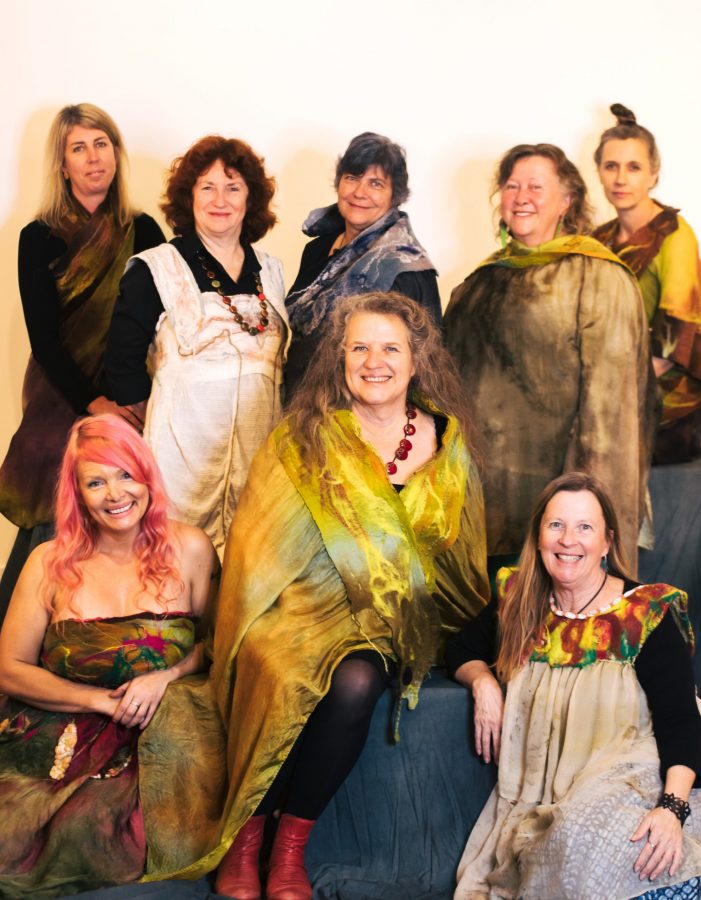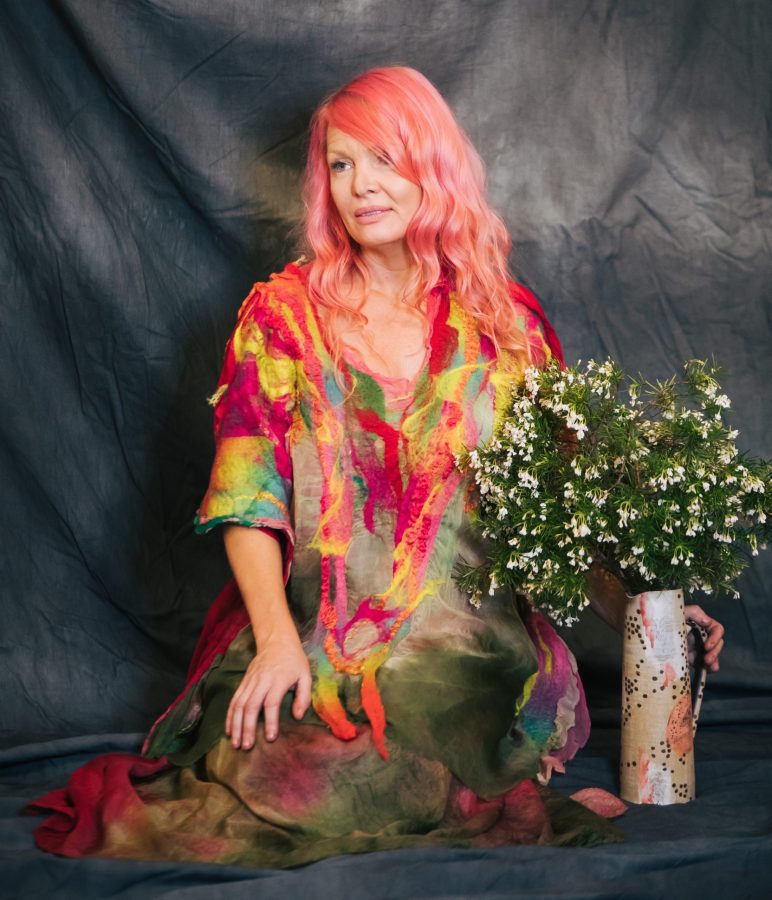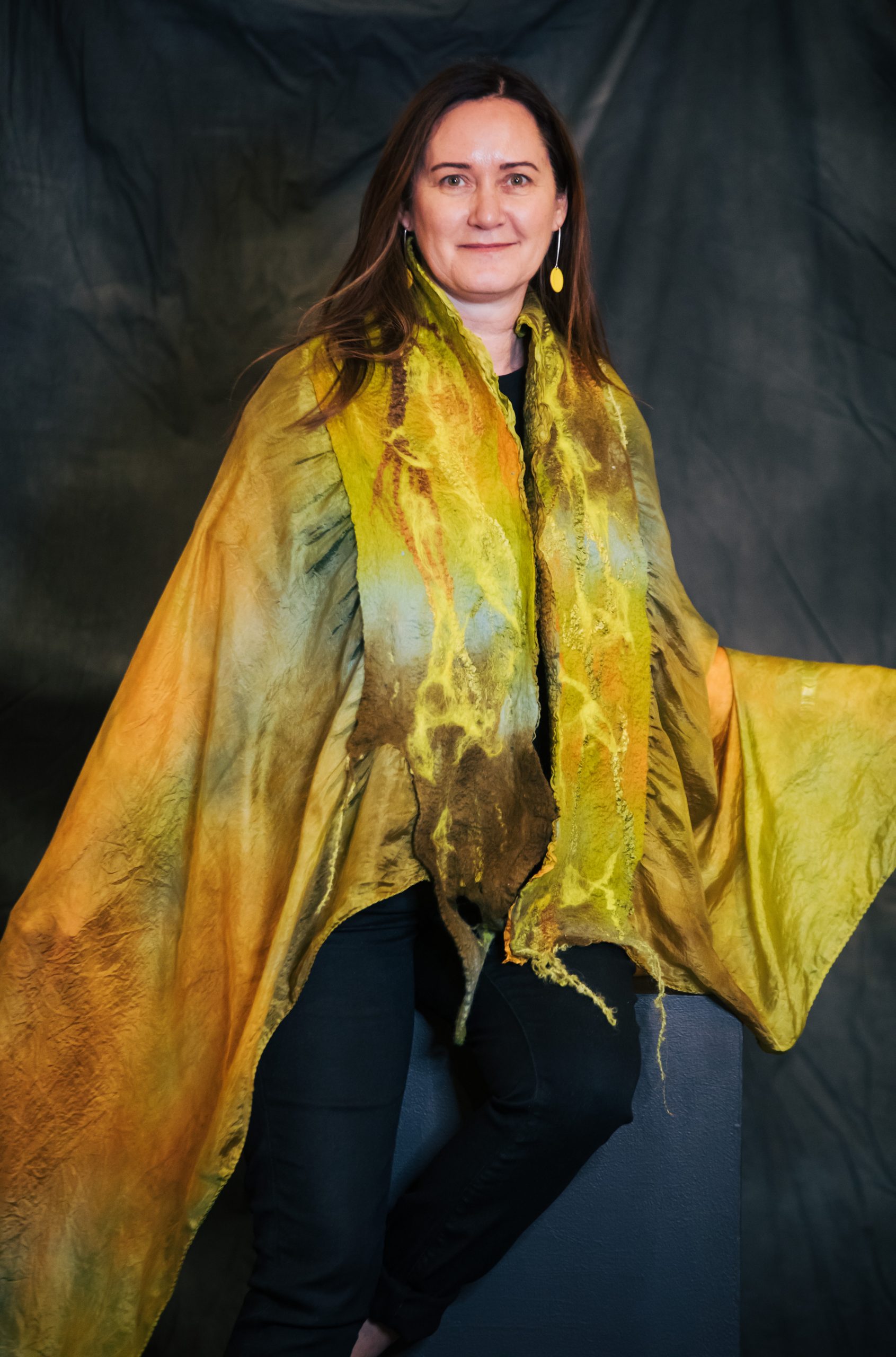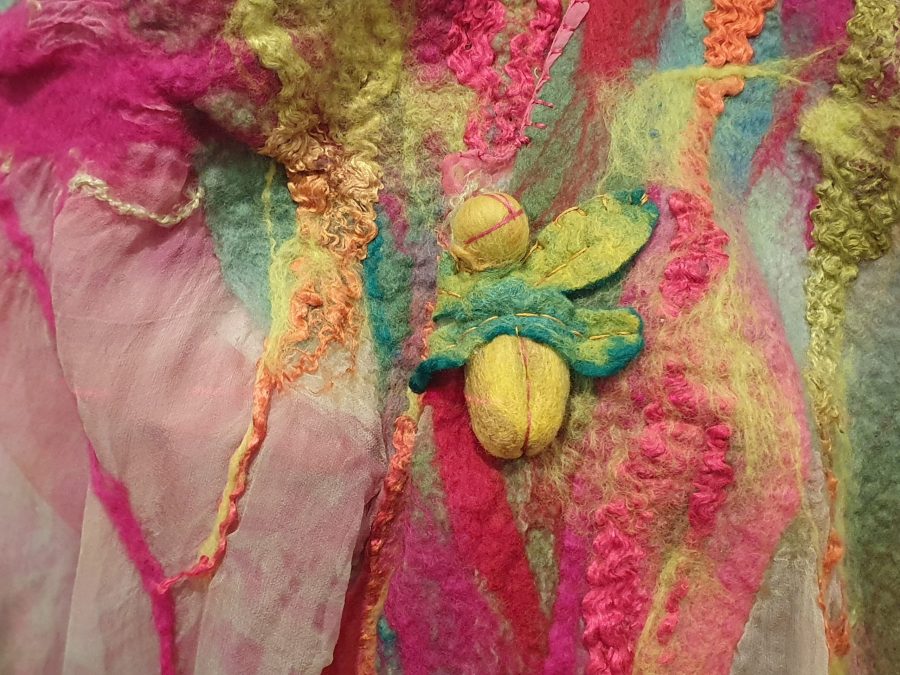EXHIBITIONWild/flower Women
Zela Bissett looks back on the origins of a groundbreaking exhibition at Gympie Regional Gallery and a robust tradition of interdisciplinary arts-science activism which underpins it.
In August 2019, a group of regional artists from the wildflower regions of the Cooloola region of Queensland met for a weekend of walking, talking and art-making.
These group included Judy Barrass, Zela Bissett, Joolie Gibbs, Nicole Harper, Anne Harris, Barbara Hart, Maree Prior, Meaghan Shelton, Melissa Stannard, Ulrike Sturm. The weekend was enriched by the guidance of Butchulla Knowledge-holder Nai Nai Bird and botanical authority Shelley Gage. The organiser behind this gathering was Dr Susan Davis, working on a Fryer scholarship to develop arts connected with a distinguished wildflower artist of the 1970s, Kathleen McArthur. She recalls:
I became interested in our wallum wildflowers through finding out about Kathleen McArthur’s work and the stories of these creative women who had been involved in campaigning to establish reserves. For Kathleen that included trying to protect areas where her beloved wildflowers grew. I wondered did they still grow in our regions? What were they? I really had no idea. Like most people I thought you had to go to Western Australia to see native wildflowers. Then when I was involved in Noosa Biosphere, Stephanie Haslam often spoke of the joys of the wallum and wildflower festival walks, I went on one of the walks and was so impressed with what I saw, I was hooked.
Credit was also due to Joolie Gibbs, in her former role as Director of Gympie Regional Gallery, who suggested that the Cooloola region should be the subject of a third Wild/flower Women exhibition, as Susan and co-curator Nina Shadforth had already worked on two previous iterations. Nina Shadforth, formerly Director of Noosa Regional Gallery, describes the progress of the project.

Noosa Regional Gallery has always had a strong association with environmental issues through much of its arts programming, for example Floating Land – which was the first time Sue and I had worked together developing education programs for Floating Land one year – I think it was 2009. We were also in close proximity to NICA (Noosa Integrated Catchment Association) where I had met Stephanie Haslem and Maree Prior and hence exposed to their work around wildflowers in the Noosa region, so the first iteration of the Wild/flower Women project was a fitting concept for the Gallery’s exhibition program.
From there, Sue and I worked together again on the second iteration of the WFW project, this time for Caloundra Regional Gallery, where the focus was more about the conservation activism pertinent to the southern end of the Sunshine Coast whereby we also invited a small number of local artists to respond to Kathleen’s artwork through new bodies of work.
After the initial weekend of immersion, the artists went back to their studios to make work for Wild/flower Women lll, but more gatherings and interactions followed. In all, they spent a year learning, walking and bonding before the exhibition was assembled, so the works seen in the collection reflect more than the act and effort of making. Their making was underpinned by complex interrelationships, between the artists and curators and with the Wildflower Country itself. Service to the environment and community had already been a big part of the lives of some of these artists, and their works are seasoned by years of observation, thought and reflection. The works certainly bear the input of the very special places where wildflowers grow, along with the other very important plants and creatures of the wallum country. The term wallum comes to us from the traditional custodians of this country, and it originally referred the Banksia aemula, a plant that Permaculture co-founder Bill Mollison has termed an indicator species for this type of plant community. The areas are found within the Great Sandy Region which includes K’Gari (Fraser Island) and the Cooloola sand-mass in south-east Queensland, a significant area of internationally recognised coastal wetlands. Citizen-led conservation campaigns during the late 1960s featured the works of wildflower artists including Kathleen McArthur and the poetry and polemic of her friend, Judith Wright. A clever strategy, which Susan Davis describes as a combination of “art, science and political nouse”, lead to a successful court case in 1970 in which the Queensland government withdrew its support for sand mining applications and subsequently established the Cooloola National Park.
The upright colourful flowers of the Banksia family are very familiar to Australians, as they are a hardy and widespread coastal species. Spending time walking, drawing, photographing, talking and sharing as this group of artists has done, reveals a wonderland of less well known plants, some shrubs bearing masses of showy bright flowers, others a slender stem bearing a single orchid lasting just a few days, or a complex of delicate filigree fronds. Time spent together on Country at Rainbow Beach helped form bonds of friendship which have encouraged the artists to try new methods and push their boundaries. With the help of Indigenous knowledge-holder, Nai Nai Bird, and botanical brains trust, Shelley Gage, the artists were privileged to spend time hearing the stories of the country among the plants of the wallum. It was illuminating to see Nai Nai and Shelley head-to-head over a tiny shrub, western knowledge meeting traditional knowledge, revealing a wealth of confluence.

Xanthorrhoea Wrap by Zela Bissett modelled by Melissa Stannard
After one year, a second weekend at Rainbow Beach was held, at which they were again able to share food, ideas and images. A big leap forward in botanical knowledge was evident throughout the group, although there were still some flowers which had to be described in print-maker Barbara Hart’s classic phrase, “the elusive white-flowering native”! A climate of trust and mutual support evolved, allowing the artists to open their eyes to the wispy stalk that precludes a rare lily, the tiny plant at the very edge of its climatic tolerance, and hear a story that one of the wildflower women can share about this tiny marvel.
In their hearts, the group held the memory of Maree Prior, a dedicated wildflower woman, activist and artist who died in April 2019. Her exhibition Wonderful, Wonderful, Wallum, which ran from 13 August – 14 September 2003 at the Gympie Regional Gallery attested to her aesthetic appreciation of the Wallum and brought it to a wider audience. Historically, wallum country, or coastal heathlands, was thought of as a second-class type of vegetation, far inferior to rainforest. Few voices were raised when it was cleared for pine plantations. But one of these voices was certainly Maree’s. She struggled gamely on many fronts to share her passion for the charms of Rainbow Beach and Tin Can Bay with those who wanted familiar plants and flowers around them, like the neighbour who planted mother in law’s tongues. It was never wise to get her started on the coastal resort’s favourite for a “tropical” look – palm trees!
Staunchly defending the coastal ecosystem against those who complained that “trees” were obstructing their views, Maree brought a new language to the teachers at the local schools.. In 2011, with a grant from natural resource management organisation, Burnett Mary Regional Group (BMRG), we presented an innovative professional development module to the staff on Ecological Literacy. Using the school grounds as our classroom, we took each teacher out for a session to show them the ecological treasures within the schoolgrounds. I especially recall Maree explaining to one teacher who wanted to cut down the insect-chewed red ash (Alphatonia excelsa) outside her door that the shrub was not unsightly, and its pitted leaves proved it was food for local insects and a crucial part of the coastal ecosystem. She suggested that a better response would be to observe and photograph what was eating the leaves and work out if they were larvae of a local butterfly, and thereby impart an important concept about Life Cycles. She showed that local people do have a practical grounding in ecological literacy, or “reading Country” when she demonstrated that all knew that the presence of paperbarks indicated poorly drained or boggy ground. Among our artists, Meaghan Shelton spent time on K’gari weeding trips with Maree as organiser.

Co-curator Nina Shadforth in Wallum Robe
The artists in this project were fortunate to have the knowledge of Nai Nai on a spine-tingling night walk to Carlo Sand Blow where she told those present a very special story. For some of the Wildflower women, this was far from their first time walking this country, but familiar territory. Joolie, Zela and Nicole had walked it in service of documenting its biodiverse treasures at the 2017 and 2018 Bioblitzes, events organized by Rainbow beach Coast Care. Nai Nai also took us on a visit to the Fire Station where she had to stand strong to protect a spirit tree in the face of men with bulldozers. K’gari (Fraser Island) is the sister country to Cooloola, where the wildflower women walked the wallum with their human and spirit guides. On a weekend organized by Queensland Art Gallery (QGOMA) exploring local involvement with significant places, Joolie, Meaghan and Zela spent time with Butchulla artist Fiona Foley, making beach installations and exploring the literal and metaphorical territory.
The patterned fens, a vast system of marshlands overgrown with wet-tolerant coastal rushes, is another unique feature of this ecosystem. An unreal feeling accompanies the walker setting out to explore the Fens through the vast mass of reeds, uncertain of what lies underfoot. The long walk in finally leads to a tiny flark, a patch of open water reflecting the bright blue of the sky. The sensation of being supported by nature rarely comes as close to an immediate experience as amongst the fens. Here, the tough strands underfoot belong to a little-known plant with the humble, if accurate, name, wire rush. Wire rush (Empodisma minus) forms a massive, fibrous super-organism extending to the horizon with greyish green spikes and tangles that support each footstep as you traverse the deep swamps where a fragile perched aquifer overlays the water table. The vast expanse of the wire rush brings to mind a super-organism from science fiction. One can readily believe the complex is as sentient as the continent-covering plants which relate all the doings of invader back to a central over-arching intelligence. In fact, researchers found that the rush has helped form the peat upon which the wetlands sit. In the first major scientific study of the patterned fens of the Cooloola Landmass, in 2014-15, Moss et al reported that
Wetland formation and development is thought to be related to a combination of biological and hydrological processes with the dominant peat-forming rush, Empodisma minus, being an important component. The wetlands dominated by E. minus are highly resilient to disturbance, particularly burning and sea level alterations, and appear to form important refuge areas for amphibians, fish and birds…
This was borne out during an evening visit to the fens in 2017 with Bioblitz birding enthusiasts. Participants listened keenly for the call of the rare ground parrot as a pinkish dusk settled over the wetlands. Just as all were losing hope, a flurry of feathers flashed into view giving a distinctive cry, disappearing an instant later into the fens. A young Butchulla girl had flushed one out for all to see. Rare creatures find refuge among the sentient rushes. Revisiting the fens with the wildflower women brought out wildflower artist Mel’s gift for ritual and sacrament. After sharing the long trek supported by the giant sentient vastness of the wire rush. into the fens, she scooped up some of the ancient water and brought it back to share with the group. On another occasion the group visited a special site on Lake Poona with many indications of a women’s area.
As artists we are engaged upon a huge project, well beyond the parameters of the visual arts, yet visual arts are essential to it. Building upon long decades of involvement by the living Wild/flower women, we can move back in time to a legacy left by others. Linking back to the work of curator Sue Davis, foundations laid by artist-activists like Kathleen Macarthur underpin our efforts. Without Macarthur, poet Judith Wright and their citizen co-campaigners, we would not have the biodiversity now still in existence at Cooloola National Park and its surrounds. Other wildflower artists such as Vera Scarthe-Johnson, whose work was recently shown at Bundaberg Regional Gallery, have been instrumental through their work in bringing the value of local native species to the attention of the public, authorities and law–makers. In a more recent example of people-power in preserving ecosystems, the victory for the Mary River in defeating the Traveston Crossing Dam proposal was assisted by artworks and collaborations with the Mary River Catchment Coordinating Committee by Joolie and Zela. Their group, Sisters of Mary, produced thousands of illustrated postcards which were sent to politicians at State and Federal levels. In costume as Mary River “nuns”, they appeared at many rallies and performed songs and street theatre.

Boronia moth detail
A Distinguished Tradition
These wildflower artists work on many fronts to celebrate not just the beauty and diversity of native plants, but the ecosystems that support them. In the arts, in education, in research, in activism, they work to move on a great project which began as early as the early colonial era, when artists strove to protect natural places by sharing their beauty and appeal with a wider public.
The massive tree ferns of the colony had visitors trooping out of the cities every weekend to view the plant wonders. Fern-filled valleys near Melbourne and Hobart were among the first areas to suffer degradation through the pressures of too many visitors. These became the scenes of some of the first public campaigns to protect places natural beauty. In 1837, Tasmania’s Surveyor-General, George Frankland, sought to prevent quarrying in a fern gully known as Salvator Rosa’s Glen, possibly the first case of protection of a place on aesthetic grounds. (Bonyhady 1993 p. 7)
Art continued to assume significance as a medium for changing how Australians looked at their environment. Eugene Von Guerard’s 1857 painting “Ferntree Gully in the Dandenong Ranges” helped spread the fame of the place and awakened public sympathy to preserve it. Famous paintings which celebrated the beauty of the Australian natural environment, William Charles Pigeunit’s The Flood in the Darling and Arthur Streeton’s Cremorne Pastoral, were declared pictures of the year in Sydney in 1895, signifying an increasing appreciation of Australian scenery.
In 1893 the lantern slides of Archibald Campbell and R.S. Sugars were used in the first known effort to preserve special natural places by showing their beauty to the public. Slide evenings were held to generate opposition to throwing open the Dandenong State Forest to selection by smallholders. This tradition continued with the famous photographic calendars by Olegas Truchanas of the Franklin River during the campaign against the Gordon-below Franklin dam in Tasmania. Returning full circle to the Cooloola region, announcer Hardie Buzzacott was fired from his job with the Gympie radio station in the early 1970s, for sharing his wonderful photographs of the Cooloola region, so effective were they deemed to be in arousing public sympathy for the preservation of the area.
A connection between the visual arts and their role in mediating a relationship between settler society and the new part of the world harks back to the colonial artists who broke away from the romantic European style of painting landscape and moved towards faithfully recording Australian scenery. The Heidelberg School painters of the late 19th century claimed to be “interested in making paintings that looked distinctly Australian”. They claimed that most earlier works resembled European scenes that did not reflect Australia’s harsh sunlight, earthier colours and distinctive vegetation. Recent researchers including Gammage (2011) and Pascoe (2017 ) have identified earlier painters such as John Glover who faithfully rendered Australia’s unique light and sprawling, untidy gum trees in the 1830s, as well as evidence of park-like landscape management by Aboriginal custodians.
The circumstances and social mores of the Heidelberg era meant that the female painters among the group including Clara Southern and Jane Sutherland could not stay overnight and camp but could only come for day visits. This limited their time spent and the amount of immersion they could achieve in the environment. This brings us back to the significance of the Wild /flower Women project, from MacArthur and Scarthe-Johnson to the present day. While painting wildflowers many seem a stereotypically female domain, the wildflowers are in fact symbolic of a greater array of Australian flora and their associated ecosystems. Nina Shadforth, co-curator of Wild/flower Women lll, when asked whether there is a special relationship between women and wildflowers, replied,
Absolutely, and I realise this is generalising, but it’s in our DNA – we (women) are maternal creatures, we instinctively know how to nurture human beings and the natural world in which we live and breathe. So I have to ask, in the first instance who do you know doesn’t love flowers? And in the second, who doesn’t enjoy the satisfaction in the discovery of colourful blooms, ever-so tiny and precious?
We are fortunate to live in a time when woman can organize their own projects, and the distinctly female sensibility that informs the WWW3 exhibition is proud of this character. The strong presence of stitching, embroidery, wearable art and dress patterns is evident in the works of Zela Bissett, Anne Harris, Barbara Hart, Sandra Ross. Melissa Stannard and Meaghan Shelton. Judy Barrass, in addition to her playful digital works, offers cut-out dolls which can be dressed and styled like the ones these artists played with while growing up.
The impact of this show was amplified by the concurrent opening of Wonamutta Burra, a show devoted to works by the family of Nai Nai Bird, who was involved with the project from its inception and officially opened the Wild/flower Women lll exhibition on October 10 2020. Sandra Ross, a contributor to the exhibition and gallery staff member, commented that with Wonamutta Burra and Wild/flower Women lll, the current exhibitions at Gympie Regional Gallery align perfectly with their current aspiration to showcase local voices, place-based work and Indigenous perspectives.
Going back to basics in creating materials was another strong feature of the works, along with transparency of technique and the use of plants in roles other than as subject matter. Joolie Gibbs’ huge 4-metre drawing is entirely rendered in botanical inks derived from native plants including the bunya nut. Anne Harris and Melissa Stannard shared the methods of making inks and dyes with their tiny bottles of samples as artworks on display. Zela Bissett made the paper for her portraits of her fellow artists from local plants. Brewing dark liquids, working with smelly pulp, these artists tap into time-honoured (and sometimes reviled) traditions of women’s work and ingenuity. The potential of these collaborations to get past outdated divisions between and science and art, Western and traditional, art and craft, is profound. Such projects have the potential to develop a new aesthetic which is firmly rooted in place, yet global in relevance.